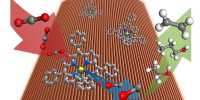The molecule benzene is found everywhere in biology, is important in chemistry, and it was also detected externally. The way in which the electrons of its constituent atoms have been divided has remained a mystery for over a century. Now it seems we have a solution and scientists have created a mathematical activity with 126 levels to get there.
Benzene has 42 electrons, so 42 times three dimensions give us 126. This does not mean that the electrons in benzene exist in 126 dimensions; it means that if we humans understand how they interact as a whole, we need to create mathematical operations that take into account the behavior of each electron in our three-dimensional world.
Benzene is a very important molecule although it is moderate compared to the figure. Six carbon atoms are located in the hexagonal ring and each of these is a hydrogen atom attached to the carbon. Carbon atoms are extremely friendly and they can bind to four more atoms, but benzene carbon can only have bonds with three other atoms, so a bond between carbon atoms is double as shown in the figure above.
Until now, it has not been possible to analyze this complex system, so the precise behavior of benzene electrons is not known, which means that the stability of molecules in technology applications is not fully understood. The question that scientists are wondering is what happens to these double bond electrons. Electrons have the same charge (negative); they oust each other so it is not easy for them to keep each other. Another property that comes into play is the spin of each electron, which can have two values, “up” or “down”.
In the Nature Communications report, the team discovered that the agreement or disagreement between the spins of the shared electrons raised a three-dimensional configuration, which had less power. Think of them as subatomic introverts, they will avoid each other if any other electron has too much energy.
“Chemists don’t think that way about benzene. It basically stabilizes the energy of the molecule by getting electrons and moving them away from each other.” Professor Timothy Schmidt, a veteran author from the University of New South Wales, said in a statement, “We were very surprised by what we got.”
The solution will help refine our theoretical perception of carbon rings, not just benzene, which is important among others in applications like graphene. The solution was able to thanks to a sophisticated algorithm that created “tiles” for each change in the electronic configuration, allowing them to map all 126 levels of correction. Developer, co-author Phil Kilby believes that this “matching limitation” software can have applications beyond chemistry. It can be used for a variety of arrangements from staff roasting to kidney exchange programs.














